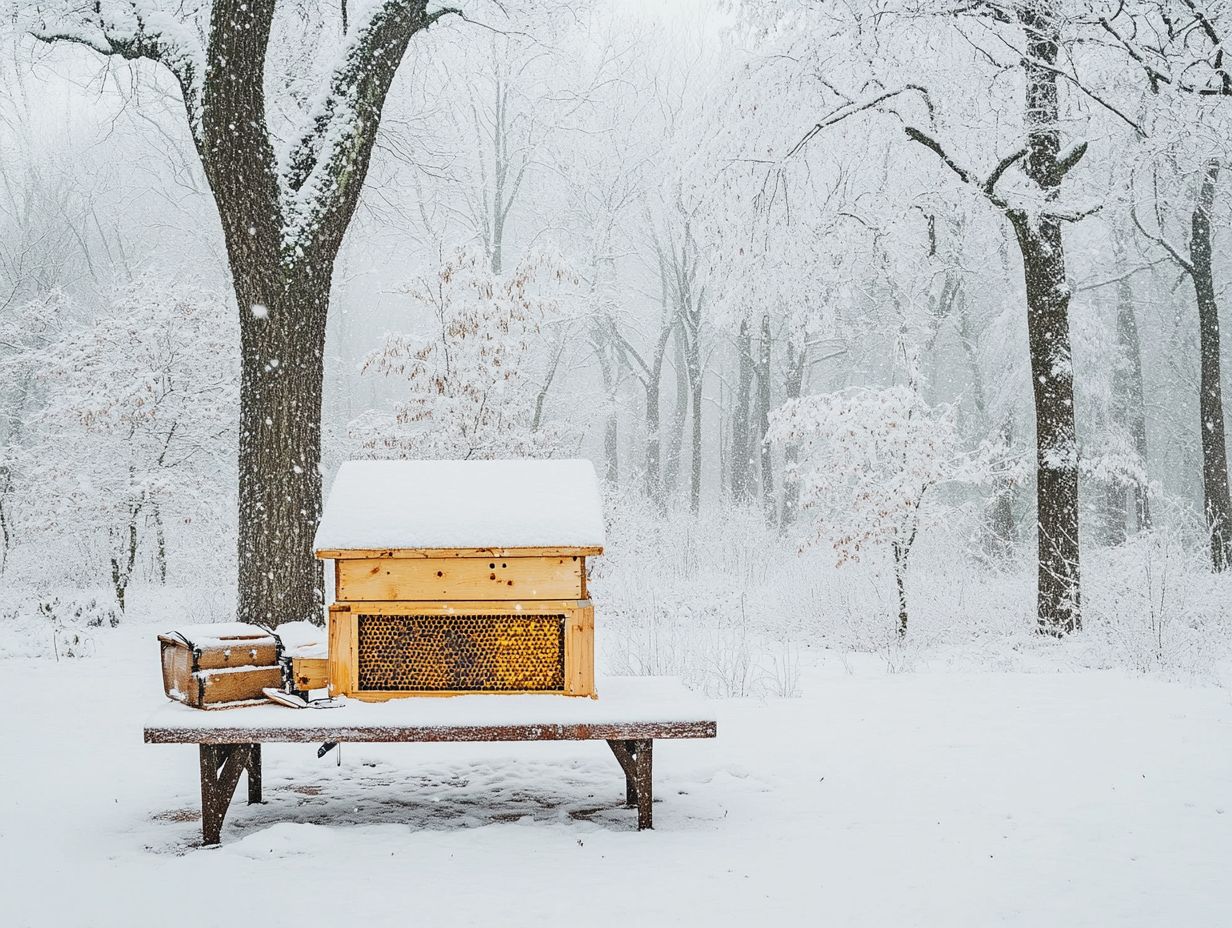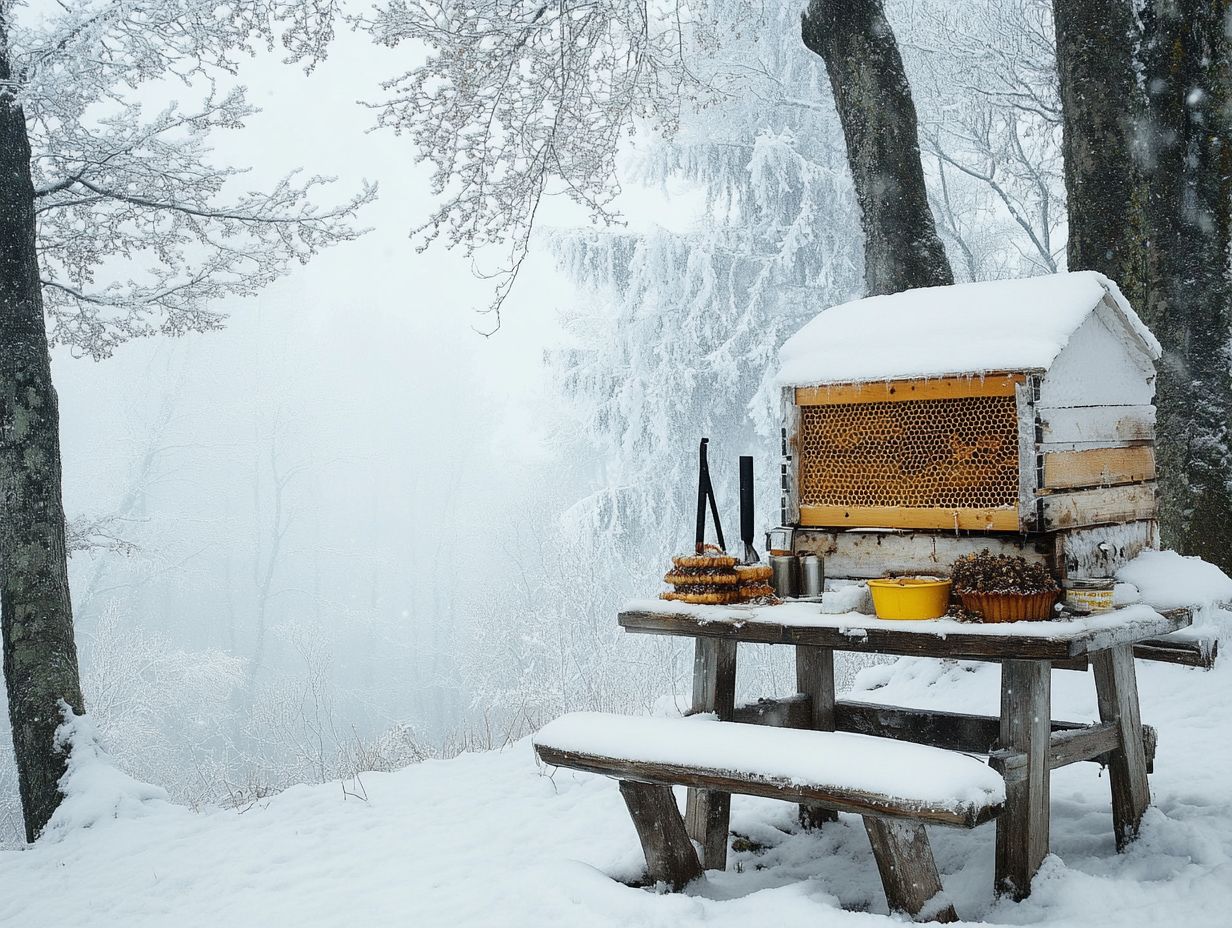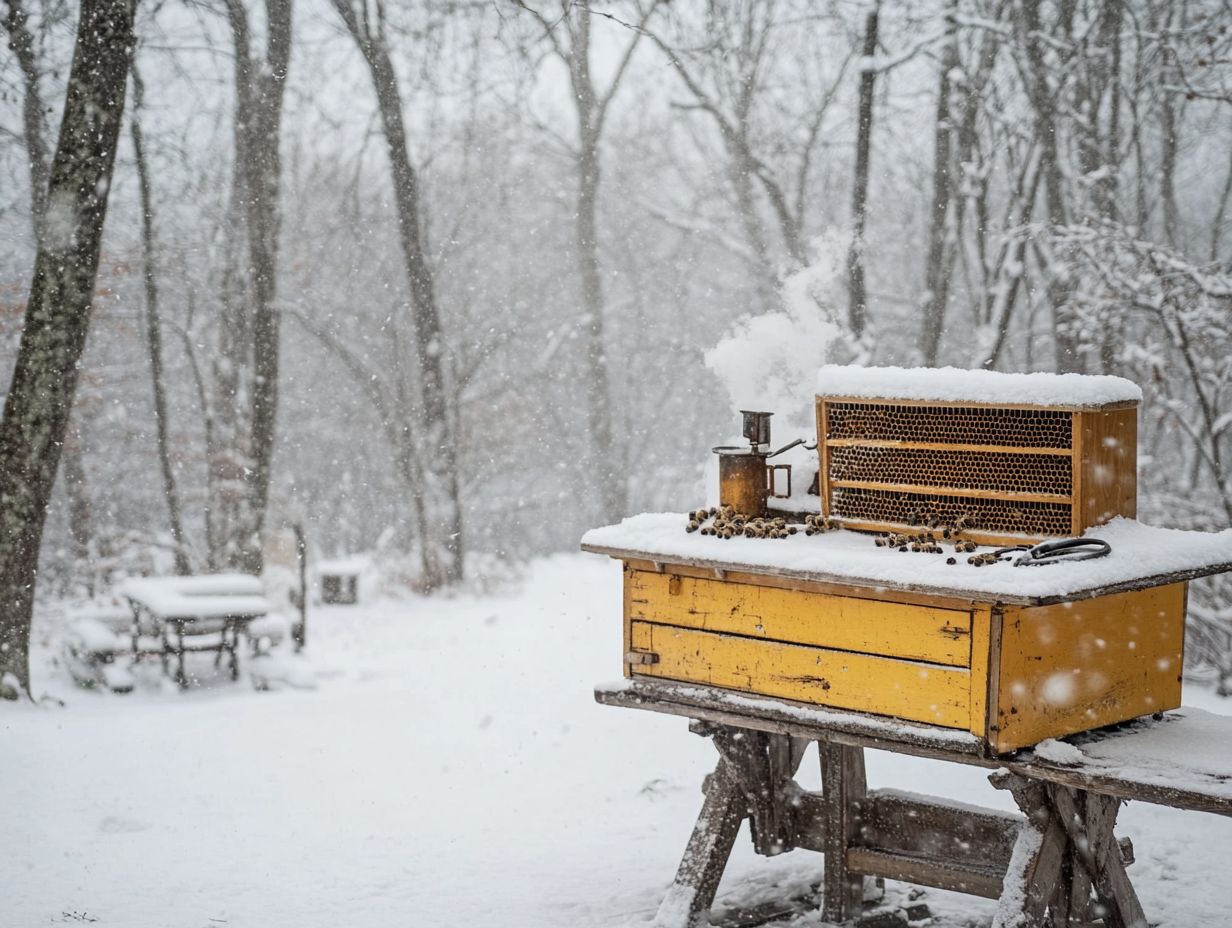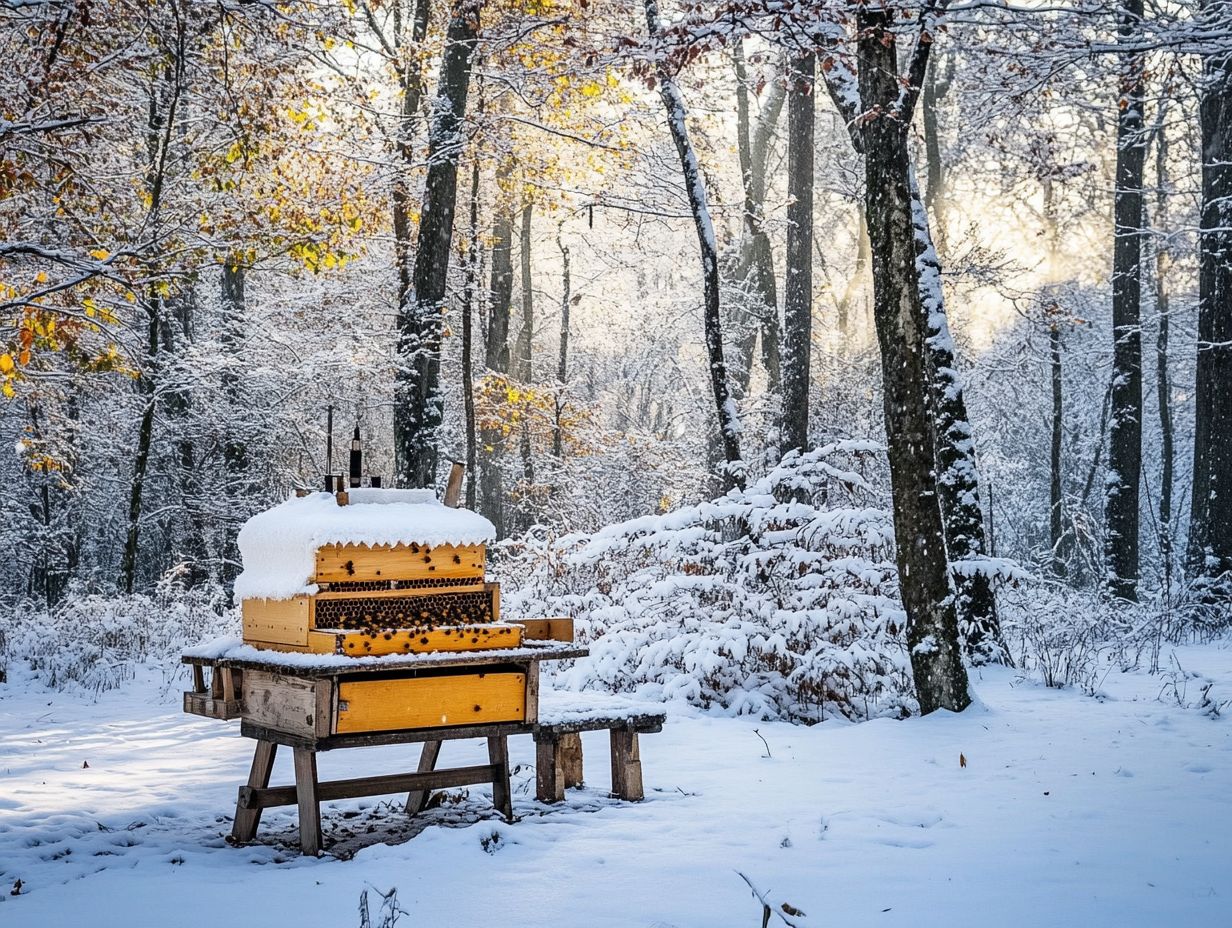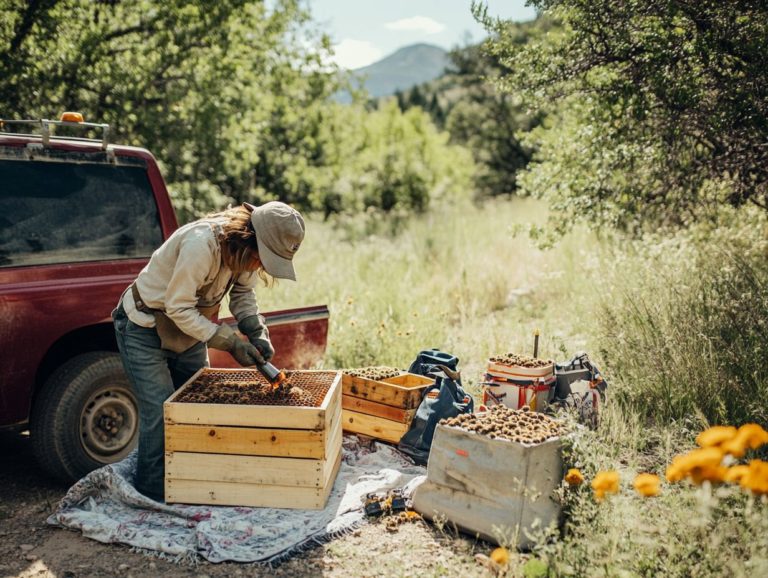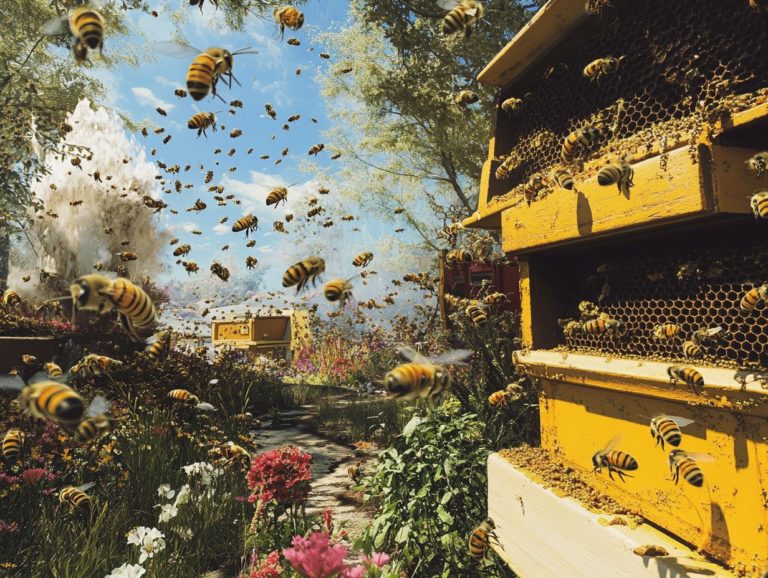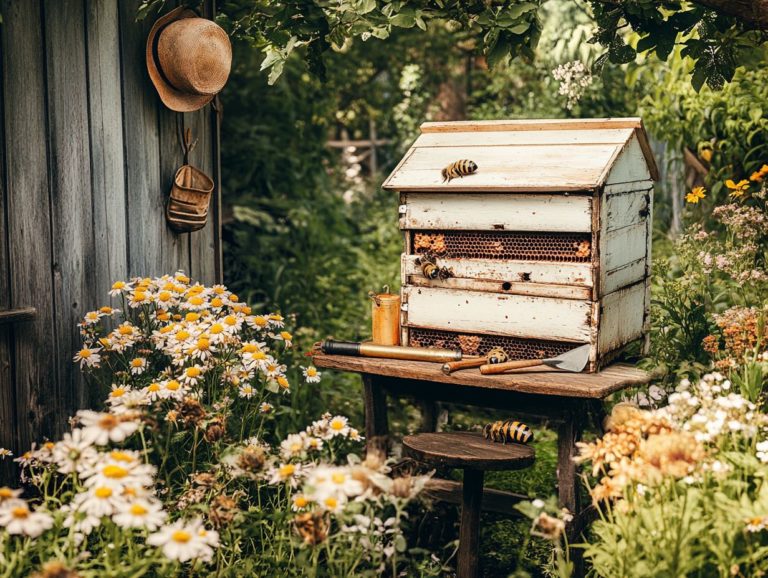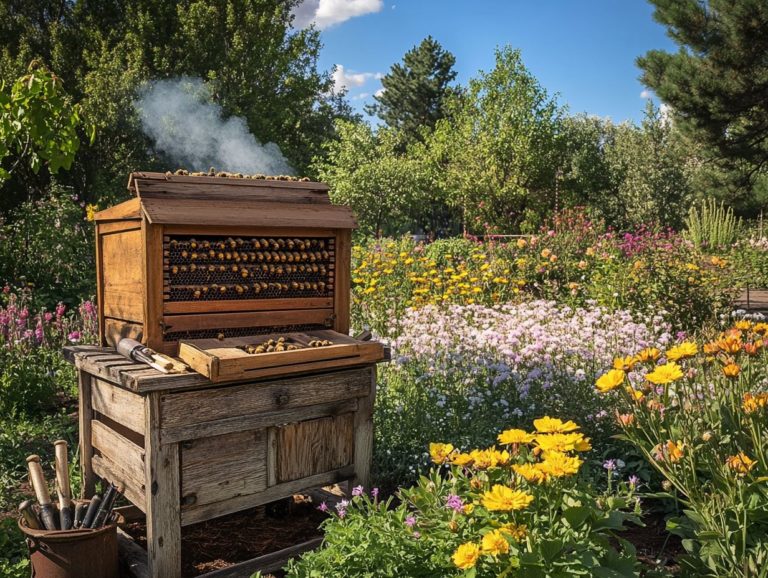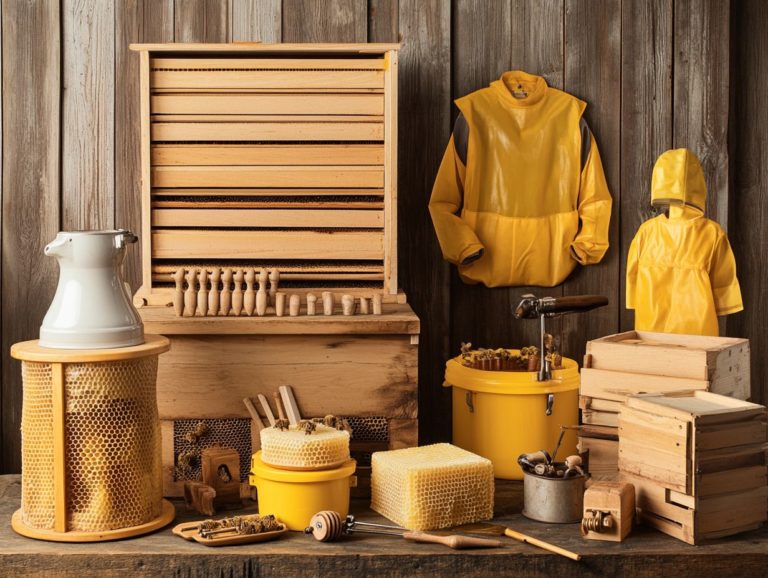Essential Equipment for Winter Beekeeping
As winter approaches, the survival of your bee colony relies heavily on your meticulous preparation and the right equipment.
From protective clothing to specialized tools like a honey extractor and uncapping knife, having the right gear is essential for successful winter beekeeping.
This guide will delve into the essential equipment you need, along with practical tips for getting your beehive ready for the colder months.
Explore the benefits and challenges of winter beekeeping, and discover best practices that will help ensure your bees thrive until spring arrives.
Contents
- Key Takeaways:
- 1. Protective Clothing
- 2. Smoker
- 3. Hive Tool
- 4. Bee Brush
- 5. Honey Extractor
- 6. Uncapping Knife
- 7. Queen Excluder
- 8. Feeder
- 9. Beehive Stand
- 10. Winter Insulation
- How to Prepare Your Beehive for Winter?
- Frequently Asked Questions
- What do I need for winter beekeeping?
- Do I need to insulate my beehives for winter beekeeping?
- What kind of moisture control devices should I use for winter beekeeping?
- Should I continue feeding my bees during the winter?
- Do I need to wrap my beehives for winter beekeeping?
- What other beekeeping supplies should I have on hand for winter beekeeping?
Key Takeaways:
- Proper protective clothing is essential for winter beekeeping to protect against low temperatures and bee stings.
- A smoker is necessary to calm bees and make hive inspections easier during cold weather.
- Investing in quality winter insulation for your hive will boost your bees’ health, ensuring they thrive all winter long!
1. Protective Clothing
In the realm of beekeeping, protective clothing is your essential barrier against buzzing stingers, ensuring both safety and a pleasant experience during hive inspections. A high-quality bee suit is vital for any beekeeper, guaranteeing safety and comfort.
Experts, including Adam Martin, a proponent of natural and sustainable beekeeping in Culleoka, Tennessee, emphasize its importance. Your specialized gear often includes gloves, adding an extra layer of protection for your hands, allowing you to work confidently without the fear of stings.
Veils are equally crucial, guarding your face and neck from overzealous bees, thus reducing the stress of hive management. Opt for breathable fabrics, especially during warmer months, to enhance your overall comfort.
Investing in quality protective gear not only makes hive management safer but can also significantly elevate your honey production. You’ll be more inclined to approach your colonies with confidence!
2. Smoker
A smoker is an essential tool in your beekeeping arsenal that helps calm honey bees during hive inspections. This makes it easier to manage your colonies effectively and safely.
By producing a cool, dense smoke, the smoker masks alarm pheromones released by the bees, which often trigger defensive behaviors. Mastering this tool can significantly reduce the risk of bee stings, turning your hive inspection experience into a more pleasant one.
When you use a smoker, puff gentle smoke at the entrance and under the hive cover to create a calming atmosphere for the bees.
Various fuels—like pine needles, burlap, and dried leaves—can generate smoke, but natural materials like wood chips from fruit trees offer a consistent, pleasant aroma.
Keeping your smoker in top condition ensures durability and reliable performance, making it a vital companion for anyone striving for successful hive management.
3. Hive Tool
A hive tool is an essential multi-functional instrument for every beekeeper. It streamlines hive inspections and makes managing your bee colonies a breeze.
With tasks like prying apart frames and scraping off excess wax, this tool is indispensable. You’ll find various designs available, from the classic flat version to specialized serrated types.
A flat hive tool is ideal for lifting frames effortlessly, while a serrated edge is handy for slicing through stubborn propolis or beeswax cappings. Each type helps you maintain Langstroth and Layens frames effectively.
Regularly inspect and clean your hive tool to prevent cross-contamination and extend its lifespan. Using the tool with a steady hand during inspections minimizes the risk of harming your bees, fostering a healthier and more productive hive.
4. Bee Brush
A bee brush is an essential tool for you as a beekeeper, expertly designed to gently and safely remove honey bees from frames during your hive inspections. This ensures that you don’t harm the bees or disrupt the delicate balance of the colony.
Crafted with soft bristles, this tool allows you to maneuver around your hives with precision. It promotes efficient honey extraction and supports responsible colony management.
When you use the brush, it’s essential to approach the bees calmly and methodically. Minimizing vibrations and sudden movements can help prevent agitating the swarm. This gentle technique is key to maintaining a tranquil environment, aiding in successful inspections and harvesting.
By mastering the right handling methods, you can enhance honey production while protecting both the bees and their habitat. This ensures that your beekeeping practice remains sustainable and harmonious.
5. Honey Extractor
In the world of beekeeping, a honey extractor is an essential tool that enables you to harvest honey efficiently from the comb without disrupting the bees’ diligent efforts. This aligns perfectly with the sustainable beekeeping practices advocated by experts like Adam Martin.
Explore the exciting world of honey extractors! They come in fantastic varieties, including manual and electric versions, each crafted to spin the frames of honeycomb and extract honey while maintaining the comb’s structural integrity.
If you prefer a hands-on approach, manual extractors offer a workout that’s perfect for hobbyists. Electric models are your best bet for larger operations, streamlining the process and cutting down on labor time.
By incorporating honey extractors into your routine, you elevate your harvesting efficiency. This practice minimizes waste and ensures that your bees continue to flourish.
Responsible honey production practices—like avoiding over-harvesting and keeping an eye on hive health—further contribute to maintaining ecological balance.
6. Uncapping Knife
An uncapping knife is an essential tool in your beekeeping arsenal, expertly designed to remove the wax caps from honeycombs. This vital step not only facilitates the extraction process but also enhances your overall honey harvesting experience.
You’ll find these knives in various forms, including both electric and manual options, each tailored to different preferences and techniques. Electric uncapping knives, often heated for peak performance, enable you to swiftly and efficiently remove caps.
This makes them particularly suitable for larger operations. On the other hand, manual knives, typically crafted from stainless steel, offer a tactile touch that many hobbyist beekeepers adore.
Regardless of the type you choose, mastering the technique of using an uncapping knife is paramount. The blade should glide effortlessly through the wax, minimizing damage to the honeycomb.
This careful approach is especially crucial with standard beekeeping frames, as preserving the structural integrity of the comb maximizes your honey yield and bolsters the bees’ productivity for the future.
7. Queen Excluder
A queen excluder is an essential tool in your beekeeping arsenal, designed to help you manage your hive with finesse. By preventing the queen bee from laying eggs in the honey supers, it safeguards your precious honey production.
This device acts as a barrier, allowing the hardworking worker bees to pass through while keeping the larger queen confined to the brood area. You’ll find two primary types of queen excluders: wooden and plastic, each with its own set of advantages and disadvantages.
Employing a queen excluder can significantly streamline your colony management. It ensures that your honeycombs remain free of brood, making the harvesting process not only easier but also more efficient.
Don’t wait! Introduce the excluder when nectar flow begins to maximize your honey production. This way, the queen stays in the brood boxes, and the workers focus on producing honey for your collection, paving the way for a more sustainable approach to honey production.
8. Feeder
Bee feeders are essential tools for you as a beekeeper. They provide crucial nutrition to honey bees during times of scarcity and help you manage your colonies better.
These feeders come in a variety of types, each tailored to meet specific needs. From entrance feeders to top feeders and frame feeders, you can select the most suitable option for your colonies.
Using bee feeders effectively is vital, especially during late winter or early spring when natural food sources might run low. By adopting proper feeding practices, you ensure that your bees have access to the necessary carbohydrates and proteins. This promotes their immunity and overall productivity.
Responsible feeding practices enhance resilience in bee populations. This leads to stronger, more adaptive colonies that can thrive even in the face of environmental challenges, such as varroa mites, which pose significant threats to honey bees.
9. Beehive Stand
A beehive stand is an essential cornerstone of your beekeeping journey. It elevates your hives off the ground to enhance colony management and streamline hive inspections.
In Culleoka, Tennessee, where the terrain can be challenging, selecting the right materials for your beehive stand—like treated wood or sturdy metals—is vital for withstanding the elements. You should also consider the design; a well-crafted stand facilitates proper drainage to avoid water pooling and provides stability against the wind.
An effective stand supports the structural integrity of your hive but also acts as a barrier against pests and reduces the risk of diseases. This ultimately safeguards the health of your bee colony.
Investing time and resources into a carefully planned beehive stand is a game-changer in your quest for successful beekeeping, especially when you attend beekeeping classes or workshops.
10. Winter Insulation
Get your bees ready for winter! Insulation is crucial for their survival. It safeguards honey bees, which are critical to honey production, from extreme temperatures, ensuring the health of your colony during the colder months.
You have a variety of insulation methods at your disposal—wrapping hives with insulating blankets, using polystyrene boards, or even installing insulated hive covers. Each technique offers distinct advantages that enhance your colony management. They help moderate temperature fluctuations, reduce energy expenditure, and create a stable environment for your bees.
As you prepare your hives for winter, ensure adequate food stores, reduce entrance sizes to minimize drafts, and check for any signs of pests or disease. Embracing sustainable practices, such as using local materials for insulation, can further bolster the resilience and longevity of your hives.
How to Prepare Your Beehive for Winter?
Preparing your beehive for winter is essential for ensuring the survival and health of your honey bees. It involves a series of strategic actions centered around winter insulation and effective colony management. These steps are vital for sustaining a thriving bee population that contributes to long-term honey production and biodiversity.
- Begin by assessing your hive for adequate supplies. Confirm that there are sufficient food stores in place.
- Utilize insulation techniques, such as wrapping your hives with specialized materials, to shield the colony from extreme temperatures and harsh weather conditions.
- Consider providing supplemental feed, like sugar syrup or fondant, delivered through bee feeders to prevent any risk of starvation.
- Conduct regular maintenance checks, crucial for minimizing moisture buildup that can lead to disease.
By integrating these practices, you not only safeguard your colonies but also promote sustainable methods that benefit the environment in the long run.
What Are the Benefits of Winter Beekeeping?
Winter beekeeping offers many benefits. It helps strengthen your colonies and boosts honey production.
By carefully managing your hives, you prepare your bees for harsh weather. This reduces the risk of pests, including varroa mites, which can harm your hives.
Effective winter strategies lead to noticeable increases in honey production in spring. Your colonies will emerge healthier and more vigorous.
These practices promote the health of your bees and benefit local ecosystems.
What Are the Challenges of Winter Beekeeping?
Winter beekeeping can be tricky. Colony starvation and temperature changes pose significant challenges.
As a beekeeper, it’s crucial to tackle these issues early. Start preparing before winter sets in by ensuring hives are stocked with honey.
Regular monitoring is essential. Keep an eye out for signs of stress or pests to allow for timely help.
Insulating your hives protects against temperature swings. Proper ventilation prevents moisture buildup.
How Can You Protect Your Bees in the Winter?
Protecting your bees in winter is vital for hive health. Focus on insulation methods and maintaining a food supply.
Being proactive helps your colonies thrive. Wrapping hives in breathable materials reduces cold exposure.
Position hives in sheltered spots to shield them from harsh weather. This creates a more stable environment.
Provide supplemental sugar or fondant to ensure your bees are nourished. Balance hive management with respecting natural bee behaviors for better survival.
What Are the Best Practices for Winter Beekeeping?
Best practices for winter beekeeping ensure your colonies stay healthy and productive. Focus on insulation, feeding, and hive placement.
Evaluate your colonies’ strength and check honey stores. Apply protective measures like windbreaks to shield them.
Monitor your hives carefully during winter. Early detection of issues allows for timely feeding interventions.
By following these strategies, you create a sustainable environment that benefits your bees and leads to thriving hives come spring.
How Can Winter Beekeeping Benefit the Overall Health of Your Hive?
Engaging in winter beekeeping can improve the health of your hive, leading to more robust colonies of honey bees and optimizing honey production as the seasons change.
By ensuring your bees are shielded from the harsh elements, you significantly reduce the risk of stress-related diseases that can harm weak bees. Using proper insulation and ventilation helps the bees stay warm, allowing them to maintain their body temperature and metabolic functions even during frigid spells.
A hive that receives proper care has a much better chance of emerging from winter in peak condition. This sets the stage for a flourishing foraging season come spring. This proactive strategy not only protects your bees but also helps you get more honey in the warmer months ahead.
Frequently Asked Questions
What do I need for winter beekeeping?
To keep your bees thriving during the colder months, you will need a few key pieces of equipment including insulation, moisture control devices, and supplemental feeding options.
Do I need to insulate my beehives for winter beekeeping?
Yes, insulating your beehives is crucial for maintaining a warm and stable environment for your honey bees, particularly in Culleoka, Tennessee. This can be done with materials like foam, bubble wrap, or even straw, which are effective insulation materials.
What kind of moisture control devices should I use for winter beekeeping?
To prevent condensation buildup and excess moisture in the hive, use items such as a top entrance, quilt box, or inner cover with ventilation holes. These devices help prevent water buildup inside the hive, which can harm the bees.
Should I continue feeding my bees during the winter?
Yes, it is important to provide your bees with supplemental feeding options during the winter as they may not have enough stored honey to sustain them. Sugar water, fondant, or pollen patties are good options for winter beekeeping.
Do I need to wrap my beehives for winter beekeeping?
Wrapping your beehives with insulation can provide an extra layer of protection against the cold and help regulate the temperature inside the hive. This is especially important for beekeepers in colder climates.
What other beekeeping supplies should I have on hand for winter beekeeping?
In addition to insulation, moisture control devices, and supplemental feeding options, it is also helpful to have tools like a hive tool, smoker, and protective gear for regular hive checks and maintenance during the winter months.
Start preparing your hive today to keep your bees happy and healthy all winter long!

